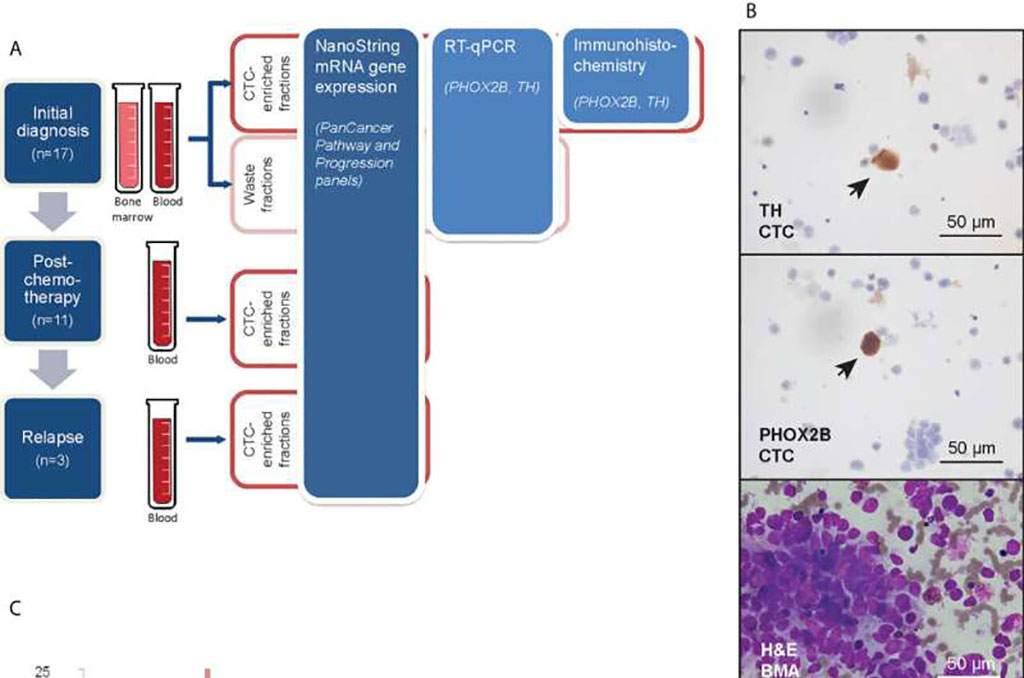A Novel Gene Signature Predicts Likelihood of Neuroblastoma Relapse
Posted on 07 Oct 2022
Cancer researchers identified distinct circulating tumor cell and disseminated tumor cell gene expression signatures that distinguished neuroblastoma patients with bone marrow metastases at initial diagnosis, and that persisted in patients with subsequent relapse.
In a recent study, investigators used a cell size-based separation technique to enrich circulating tumor cells (CTCs) from blood samples and disseminated tumor cells (DTCs) from bone marrow aspirates (BMA) of neuroblastoma patients and subsequent genetic mapping in order to identify those patients most likely to relapse following treatment.

Neuroblastoma is the most common extracranial malignancy of childhood and responsible for a disproportionate number of deaths from childhood cancer. Nearly 60% of neuroblastomas relapse in distant sites, most commonly bone marrow. Disease relapse is thought to arise from undetected, chemotherapy-resistant cells.
Considering the relative size differential of neuroblastoma tumor cells over normal hematogenous cells, investigators at the National University of Singapore (Singapore) sought to identify biomarkers characteristic of such cancer cells by enriching and characterizing intact circulating cells in peripheral blood containing neuroblastoma CTCs, as well as their DTC counterparts in the bone marrow.
For this study, the investigators employed a spiral microfluidic chip to analyze peripheral blood from 17 neuroblastoma patients at three serial treatment timepoints (diagnosis, n=17; post-chemotherapy, n=11; and relapse, n=3), and bone marrow samples at diagnosis were enriched for large intact circulating cells.
Results revealed that expression of eight genes associated with PI3K and GCPR signaling were significantly upregulated in CTCs of patients with bone marrow metastases versus patients without. Correspondingly, in patients with marrow metastases, differentially-expressed gene signatures reflected upregulation of immune regulation in bone marrow DTCs versus paired CTCs samples. In patients who later developed disease relapse, five genes involved in immune cell regulation, JAK/STAT signaling, and the neuroblastoma mesenchymal super-enhancer state (OLFML2B, STAT1, ARHGDIB, STAB1, TLR2) were upregulated in serial CTC samples over their disease course, despite urinary catecholamines and bone marrow aspirates not indicating the disease recurrences.
"We hope that this method can replace current invasive methods such as sampling of bone marrow in the near future, and be potentially expanded to other childhood cancers," said senior author Dr.Chen Zhi Xiong, associate professor of physiology at the National University of Singapore. "We are also exploring the use of circulating cancer cells to better understand the biology of neuroblastoma and variations in treatment response to provide more personalized care for neuroblastoma patients. Besides cancer cells, we are also investigating other circulating biological entities in blood that may provide further options to monitor treatment effectiveness, and help predict cancer spread and relapse in childhood cancers."
The study was published in the September 13, 2022, online edition of the journal Frontiers in Oncology.
Related Links:
National University of Singapore













